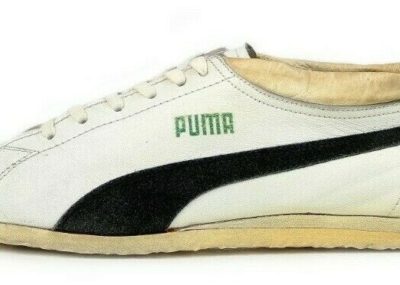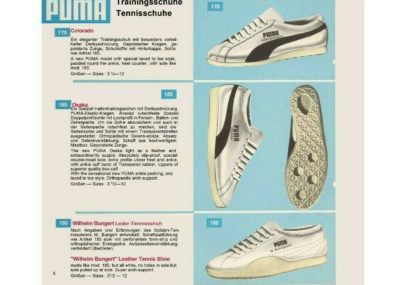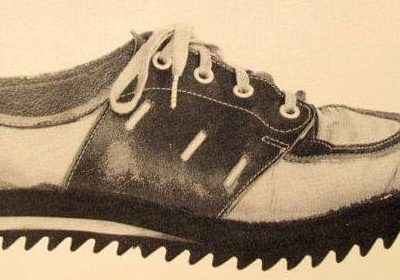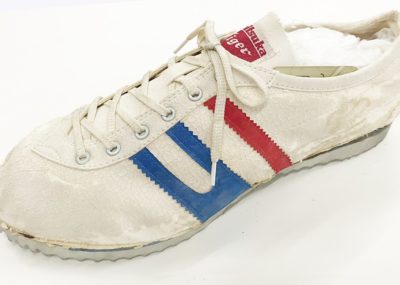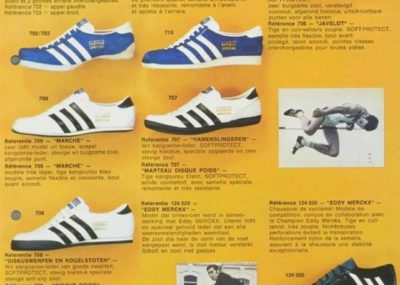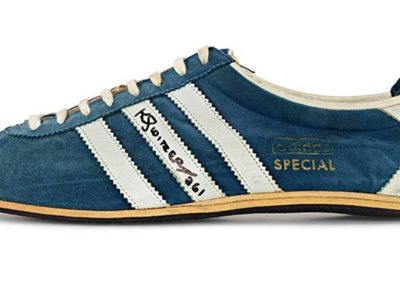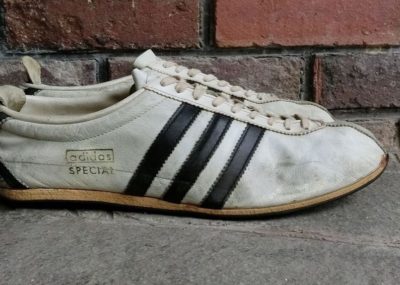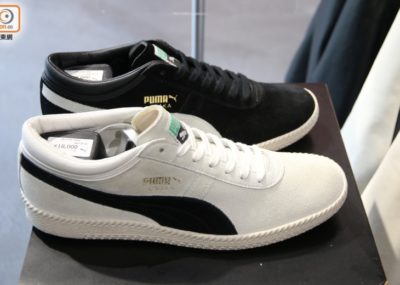21-Oct-1964 – Tokyo Olympics – 2:12:11.2 – Puma Osaka
Date of birth: 7-Aug-1932 (died 25-Oct-1973 – aged 41)
Nationality: Ethiopian
World Record Duration: 7 months, 22 days
Olympic Record Duration: 11 years, 9 months, 10 days
The athlete:
Following his success winning the 1960 Olympic marathon barefoot, Bikila had become an overnight celebrity. He would go on to race one more marathon barefoot, the legendary course from Marathon to Athens, the home of the marathon legend itself. It was the venue for the first modern marathon at the 1896 Olympics. The course was modelled on the legend of Pheidippides and his run from Marathon to Athens to announce Greek victory at the Battle of Marathon.
Incredibly, Bikila was handed flowers from the crowd at several points during the last ten kilometres. He felt it rude not to take them, handing them back later to other members of the crowd. Such was his lead that this gesture did not slow him down significantly. Bikila not only won the fabled event , but set the new course record in the process.
Crowds of excited fans met him when he landed in Japan in 1961, including one Kihachiro Onitsuka, the owner of a small shoe company bearing his name. Bikila was in Japan to compete in the Mainichi Marathon, and his coach Onni Niskanen was concerned about the rough conditions of the roads that he would face.
Based on these concerns, Bikila was finally introduced to Onitsuka, who echoed his coach with warnings about the rough ground. He described his feet like cat’s paws, but said with shoes he could go even faster. Bikila relented, and won the marathon easily, admitting the Onitsuka Tiger Marup shoes gave him better grip along the way. Bikila would wear the Marup later that year to win the Košice Marathon. The Marup, with its rubber sponge midsole and minimalist upper, was easily the most popular racing flat of its era.
Come 1963 he attempted the Boston Marathon in the New Balance Trackster, likely provided by the company that itself was based in the same city. The model was known for the rippled outsole which helped provide more cushioning. It was extremely popular for this reason and helped launch New Balance as we know them today. As for Bikila, he finished fifth, his only loss in an international marathon during his competitive career. 1964 marked the opportunity to win more Olympic gold, and Onitsuka reached out to Bikila about his footwear choice. They were told by Niskanen that Bikila had other commitments. What would become clear is that Puma had agreed to provide him with his latest shoes.
It almost amounted to nothing. Forty days before the Olympics, Bikila collapsed during training, the diagnosis acute appendicitis. Bikila started training again shortly after his surgery. Even after his rapid recovery, he would injure himself in Tokyo when he fell while riding one of the bikes organisers had provided to athletes. Bikila went to hospital to have his hand looked at, but was afraid to have doctors look at his knee which was more seriously injured. He hid the injury, and got Niskansen look at his knee on return to the Olympic village. Fortunately there was nothing to worry about, but cycling was forbidden from then on.
It all came together on the day of the marathon itself, Bikila working his way into the lead by the halfway mark. He showed little sign of exhaustion after not only winning but setting a new world record, going through exercises as if he were about to run again. His nearest rival, then current world record holder Basil Heatley, was four minutes behind him.
In the following year he would have another attempt at the Mainichi Marathon, still wearing the Puma shoes that had secured him his second gold medal. It was another dominant performance, Bikila finishing nearly three minutes ahead of Hirokazu Okabe. It is possible that Bikila may have again crossed paths with Onitsuka, because by 1966 he could be spotted in the Zarauz International Marathon and Incheon–Seoul Marathon wearing the distinctive Onitsuka Tiger Super Marup. It was the latest development in the highly successful Marup line Bikila had worn earlier, the striped midfoot overlays visible in footage of both events. It may have also used the Clarino synthetic leather uppers that were introduced more widely that year. Both times Bikila secured comfortable victories, his path to another gold medal seemingly set out before him.
His next year would bring mixed fortunes at best. At the Zarauz International Marathon he collided with another competitor which injured his hamstring. It was an inauspicious renewal of his relationship with Adidas, Bikila now wearing what looked like the aptly named Marathon, designed to be as lightweight as possible. Although one catalogue shows them as being available only in white leather, in another they are shown in the distinctive blue kangaroo velour used by Adidas in many of its shoes during that period. The Marathon was also worn by distance running legend Kathrine Switzer when she famously fought off track officials to compete in the 1967 Boston Marathon.
He would eventually go to Germany in 1968 to have the lingering injury looked into and, seemingly recovered, he started training and made the Ethiopian team for the 1968 Olympics. One week out from the race, Bikila developed pain in his left leg. Doctors confirmed that it was a fractured fibula, and advised him to rest until the day of the race. Bikila was undeterred, and would still sneak out to train in the middle of the night. Incredibly, he took the start and while initially competitive, he had to stop at the 15 kilometre mark when the pain became unbearable. Legend has it that he told countryman Mamo Wolde that it was now his responsibility to win gold for Ethiopia.
History would show that Wolde would go on to win the marathon at the 1968 Olympics. Bikila was still wearing what appeared to be the Adidas Marathon , as was Wolde . It was an interesting bookend to the last three Olympics for Bikila, who had allegedly bought Adidas shoes in Rome before deciding to run barefoot at the 1960 Olympics. Although he could not have secured another victory, Adidas could still claim some of the spotlight through Wolde.
Tragically, Bikila would not get another chance at Olympic glory. Following a car accident in 1969, Bikila was initially left quadriplegic. After first being treated in Ethiopia, he was transferred to England. After eight months of treatment, he miraculously recovered control of his upper body. His athletic drive had not diminished, and he competed in archery at the International Stoke Mandeville Games, the precursor to the Paralympic Games.
He would make one last appearance at the Olympics as a special guest in 1972, but lost his life one year later from complications relating to his 1969 accident. More than 65,000 people farewelled Bikila, who not only inspired his countryman and the world, but also sparked the rise of African distance running.
The shoes:
Puma are justifiably proud that it was their shoes that Bikila wore to win another Olympic marathon. For the Osaka model, Puma employed several features to make sure they were ready for the distance. The midsole was lightweight and flexible, with sections cut out to further reduce weight. The shoe design aimed to mimic the feeling of barefoot running. The upper featured a padded collar, to make the shoe as comfortable as possible over the marathon.
Puma actually brought back the Osaka in 2014, as an incredibly limited release in Japan. They were released on the second anniversary of the Puma store in Osaka, which was also the 50th anniversary of Bikila’s achievement. The colourways available were white suede with black overlays or black suede with white overlays. They were not completely faithful to the original, with the toebox being one piece and the upper being made fully with suede. They are, however, the closest you can get to what Bikila wore on that fateful day.
References:
Bikila: Ethiopia’s Barefoot Olympian by Tim Judah
The Adidas Archive by Christian Habermeier and Sebastian Jäger
https://en.wikipedia.org/wiki/Abebe_Bikila
https://www.puma-catchup.com/marathon-runner-icon-and-puma-athlete-abebe-bikila-won-at-the-tokyo-olympics-in-1964/
https://theolympians.co/2015/09/25/sneaker-wars-part-3-abebe-bikila-onitsuka-vs-puma/
https://tokyo2020.org/en/news/abebe-bikila-wins-marathon-gold-40-days-after-appendicitis-surgery
http://www.bikilaaward.org/about_us/bikila/index.html
https://aims-worldrunning.org/articles/655-abebe-bikila.html
https://www.ebay.com/itm/154318743463
https://hk.on.cc/hk/bkn/cnt/lifestyle/20160526/bkn-20160526114854571-0526_00982_001.html
https://www.runnersworld.com/advanced/a20820241/shoes-of-our-youth/
https://www.instagram.com/p/CCYPd-VjqzJ/
https://corp.asics.com/en/about_asics/history
https://about.puma.com/en/this-is-puma/history
https://news.google.com/newspapers?id=ODtaAAAAIBAJ&pg=4691%2C1982439
https://www.heddels.com/2019/07/new-balance-brand-history-philosophy-iconic-products/
https://www.instagram.com/p/BeP6JVoFl33/
https://lydiardtrainingandacademy.medium.com/long-live-the-king-bd6526ecb751
https://www.historyextra.com/period/ancient-greece/pheidippides-marathon-runner-battle-athens-persia-sparta/
http://www.racingpast.ca/bob-phillips.php?id=25
